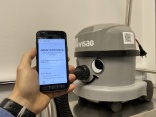Home › magazine › latest news › Fleet management based on IoT technology
Fleet management based on IoT technology
16th of June 2025Managing machines, equipment and tools is a massive challenge for cleaning companies, particularly when it’s still done manually. Implementing a centralised IoT platform as the foundation for a vendor-agnostic fleet management system can help streamline operations - says Alexander Manafi, co-founder & CEO of asset operations management specialist ToolSense.
Managing machines, equipment, and tools is a massive challenge for cleaning companies - especially when it’s still done manually. Implementing a centralised IoT platform as the foundation for a modern, vendor-agnostic fleet management system can help streamline operations significantly.
Challenges in the cleaning industry
The cleaning sector is under increasing pressure: Costs are rising, quality expectations are growing, and sustainability and regulatory requirements are becoming more demanding. Digital technologies like the Internet of Things (IoT) are gaining attention as a way to monitor, control, and optimise machines and processes end-to-end.
But how can IoT help in practice to unify a wide range of systems? And what are the key challenges when implementing such a platform?
Let’s start with the current situation. Despite progress in digitalisation - for example, ERP systems, time tracking, or quality control - many cleaning companies still rely on manual tools to manage their equipment. From Excel sheets and paper lists to isolated OEM portals for traditional machines and advanced robots, the result is fragmented processes, higher error rates and longer downtime.
A common real-life example
One robotics technician from a well-known cleaning company in Germany and Austria reported that he checks seven different apps every morning to see if any of the cleaning robots had issues overnight. If a problem arises, he must call the site manager, who then coordinates with team leads, travels to the site to inspect or remove obstacles, and finally contacts the manufacturer via phone or email. This manual, multi-step process leads to significant machine downtime.
The core problem areas
Two major issues arise when trying to digitise facility service fleets uniformly:
1. Too many systems, no central view - Cleaning companies often use machines from multiple manufacturers, each with its own telematics solution. There’s rarely a central platform to consolidate this data, making real-time monitoring, optimisation and automation nearly impossible. Teams fall back on Excel and manual evaluations, especially as robotic systems add even more complexity and vendor diversity.
2. No IoT for small or older devices - While many modern machines have OEM-specific IoT, smaller devices (for example, vacuums, single-disc machines) and older assets often don’t. Without tracking this large portion of the fleet, process control and utilisation optimization become unfeasible.
One central platform for everything
The solution: a centralised platform that aggregates all data from machines, tools, and vehicles - regardless of type or age.
For older equipment, retrofit IoT modules can be installed to capture data like location, runtime, or battery cycles. These modules are simple enough to be installed by non-technical staff.
For smaller tools, Bluetooth tags offer a low-cost alternative (around €15-€20), enabling tracking and automated inventory. These tags can interact with IoT modules in other devices, vehicles or gateways, creating a mesh network that tracks device location automatically. For instance, a vacuum with a Bluetooth tag might register itself via a scrubber dryer’s IoT module or upon returning to storage.
Large OEMs like Hako, Kärcher, Taski, Gausium and Pudu offer their own fleet solutions (Kärcher Equipment Manager or Taski IntelliTrail for example). Platforms like ToolSense consolidate and harmonise their data - so site managers can access everything through one dashboard, instead of checking multiple apps.
Open interfaces are critical
When buying new machines with OEM telematics, it’s essential to check whether the manufacturer provides an API (Application Programming Interface) to connect with central platforms. Most do - some still don’t, often due to technical or strategic constraints. In such cases, companies should ask for third-party integration options to avoid vendor lock-in.
Robotics in cleaning is booming, with companies like CenoBots, Gausium, LionsBot, Nexaro and Softbank Robotics addressing labour shortages and cost pressures. But all these connected devices risk becoming yet another isolated system - unless platforms provide open integrations (via REST, GraphQL, etc) to funnel data such as run times, errors, and maintenance needs into a centralised IoT platform.
Real-world examples
This is not just theory. Several companies are already seeing real impact:
• Example 1 - mid-sized cleaning firm. A German facility service provider used over 150 scrubber dryers from three OEMs. Many were under utilised. With an IoT platform, they analysed actual usage, redistributed idle machines and avoided unnecessary new purchases. And machine costs were cut by 15 per cent.
• Example 2 - hospital with in-house cleaning team. A hospital using hundreds of devices lacked central data on lifecycle costs, usage, or condition. Repairs were handled by a regional partner, but there was no transparency. After IoT and process software was introduced, management discovered that average downtime was 60 days per machine.
By retrofitting IoT modules and training staff on battery care (for example, to avoid four to five daily charges), they drastically reduced costs. Damage reports via QR codes are now sent instantly to the service provider, leading to downtime reductions from 60 days to under 10 days in just
five months.
Conclusion
Introducing an IoT platform lays the foundation for broader digital transformation. Especially in predictive maintenance, further efficiencies are on the horizon—potentially with AI-driven diagnostics to prevent breakdowns before they occur. The benefits for cleaning firms: lower costs, saved time, better utilisation, and more efficient teams.











